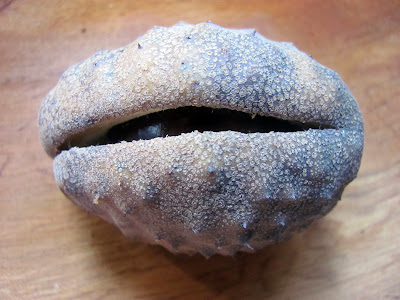eye of the buck
opening slowly from inside
its prickly pod
When I was growing up, we lived for some years in Ohio, the Buckeye State. The lawn behind our house sloped down to a woods that bordered old railroad tracks. A short walk down the tracks was the "bum's house," an abandoned concrete shell with empty windows, the walls covered with graffiti, and on the floor a blackened spot from cooking fires.
We had our own fire pit in our little parcel of the woods, surrounded by logs for sitting around the fire at night, watching the orange sparks fly up from the flames to join the stars peaking through the tree canopy, roasting marshmallows for s'mores and telling tall tales. Sometimes we threw buckeyes in the fire, daring each other to eat the roasted nuts. We saw squirrels eating the raw nuts, but they knew how to chew through the pink outer layer, which is very bitter, to the white inner heart. Once, I tried doing what I heard that the Native Americans did, roasting, mashing and grinding the seeds into a meal which for porridge, but it was not very satisfying.
During the afternoons and on weekends we ran around in our woods playing games. One of our favorites involved buckeyes. The equipment was simple, but took some time to construct. In early autumn, when the buckeye trees dropped their seed pods, the greenish-gold, leathery husks would split open, revealing one or sometimes two glossy, chestnut brown seeds with a pale circular "eye" that looks like the eye of a buck. Everyone carried a favorite buckeye for good luck, and just for the marvelous feel of the smooth orb. But for this game you searched for the biggest buckeye you could find, through which you drilled a hole and tied one end of a long string through the hole.
The game consisted of two kids bashing their buckeyes together with the goal of breaking the other buckeye. If you did, you got to add that "coup" to your buckeye. If you broke a buckeye that already had a total coup of seven, then you got to add seven strikes to your buckeye. It took a good deal of mind-body coordination to get two flying objects to connect, and we learned from experience about momentum, velocity, vectors and what happens when two bodies collide. Sometimes the collision involved the other person's arm or hand, but that strike didn't count and could result in your friend holding a strike against you, which was another kind of lesson.
I still like to collect buckeyes in the fall, but now I leave them in their shells and put them in a bowl on the dining table so I can watch the spiny husks slowly open like eyelids, revealing shiny dark brown eyes.









No comments:
Post a Comment